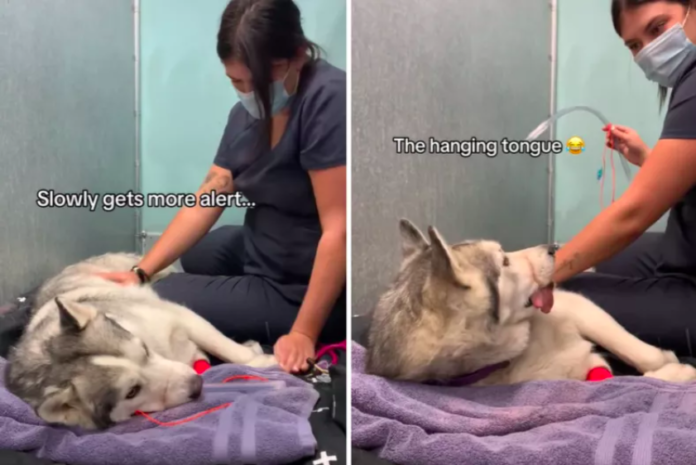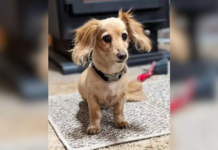Table of Contents
ToggleLast Updated on November 11, 2024 by Fumipets
Tears at How Husky Wakes Up From Anesthesia at Vets: ‘He’s Just a Baby’
Introduction
In a heartwarming and adorable moment captured on video, a 7-year-old Siberian husky named Wiley recently had the internet swooning over his reaction to waking up from anesthesia. In a video that quickly went viral, Wiley is shown slowly stirring awake after a routine veterinary procedure. His unique personality shines through, even as he groggily adjusts to his surroundings. This article dives into the endearing details of Wiley’s experience, why dogs sometimes act in unexpected ways post-anesthesia, and whether they can “fake” certain behaviors for attention.
Wiley the Husky: A Dramatic Waking Moment
Sally Compton, Wiley’s owner from Oregon, shared the touching video on her TikTok account, @pnwsally. The clip shows Wiley stirring from anesthesia, his eyes half-open, and visibly disoriented. The veterinary staff carefully removed his breathing tube as Wiley gradually became more alert. Sally noted, “Huskies have the biggest personalities, even when under anesthesia.”
Why Was Wiley Under Anesthesia?
Wiley was at the vet for a routine teeth-cleaning session. Although it was a minor procedure, anesthesia was required to keep Wiley still and calm during the cleaning. His reaction upon waking up, however, made it look as though he’d been through a major ordeal. The lovable husky appeared dramatically confused and quickly melted the hearts of viewers worldwide.
Huskies: Known for Their Dramatic Nature
Huskies, like Wiley, are widely recognized for their dramatic personalities. This breed is famous for its vocal expressions, energy, and often theatrical responses to simple situations. Owners frequently share stories of their huskies’ exaggerated reactions to everyday events, whether it’s a bath, a nail trim, or a simple checkup at the vet.
Do Dogs Fake Injuries for Attention?
One of the biggest questions raised by Wiley’s video is whether dogs can “pretend” to be hurt or sick for attention. According to canine behavior experts, the answer is both yes and no.
Understanding Canine Behavior and Motivation
Dogs typically don’t have the cognitive ability to plan deception the way humans do. However, dogs can learn that specific behaviors elicit certain responses. When a dog receives extra love, treats, or attention after displaying a particular behavior, they may repeat it in the future without fully understanding the reason behind it. This concept, known as positive reinforcement, can lead to dogs unconsciously mimicking the behavior that led to the reward.
Veterinary Insight: Can Dogs “Fake” Pain?
Veterinary surgeon Dr. Linda Simon from The Dog Clinic explains that dogs don’t consciously fake pain or illness. However, they may “learn” that acting a certain way can bring them comfort or rewards. Although huskies are dramatic by nature, this reaction typically isn’t a planned behavior but rather an instinctive or conditioned response to an unfamiliar situation.
How to Tell if a Dog Is Faking Injury
While it’s unlikely for a dog to intentionally fake an injury, there are ways to assess if their behavior is genuine or exaggerated. According to Vet Explains Pets, some signs may indicate when a dog isn’t truly hurt:
- Sudden Improvements: If a dog shows sudden improvements after receiving attention, they may have just been seeking comfort.
- Inconsistencies in Symptoms: Dogs who act hurt inconsistently, such as limping only when being observed, may be overemphasizing.
- Exaggerated Reactions: Overly dramatic or exaggerated reactions can suggest that a dog is responding more to the attention than any actual pain.
- Lack of Response to Pain: Dogs who don’t react to real pain triggers but display hurtful behavior otherwise could be seeking attention.
Why Dogs Hide Pain Rather Than Fake It
Dogs are more likely to hide pain than to fake it. Descended from wild ancestors, dogs still carry instincts to mask pain, as showing vulnerability could make them appear weak. This instinct, paired with their natural loyalty and trust in their owners, often leads dogs to hide discomfort rather than exaggerate it. However, once dogs associate certain behaviors with positive reinforcement, they may inadvertently repeat these actions for comfort.
Wiley’s Viral Fame and Social Media Reactions
Wiley’s reaction resonated widely with TikTok users, generating over 2.6 million views and hundreds of thousands of likes. Comments poured in from fellow husky owners and dog lovers who shared their own stories of post-vet dramatics.
- One user, Southerncurls from Texas, commented, “My husky was the same way. Drama kings.”
- Korie La Volpe Audit recalled, “My poor husky howled all the way home after surgery. It was an HOUR drive of the absolute saddest howls.”
- Lia Nielsen added humorously, “Nothing makes a husky even more dramatic and loud like anesthesia.”
Common Reasons for Dogs’ Post-Anesthesia Reactions
When a dog wakes up from anesthesia, the effects can leave them disoriented and sensitive. Common reactions include grogginess, wobbling, and even vocalizing or howling. Here are some typical reasons for these behaviors:
- Residual Effects of Anesthesia: The drugs used in anesthesia affect the central nervous system, leading to a temporary state of confusion.
- Muscle Weakness: Dogs may experience temporary muscle weakness, making it hard to stand or walk.
- Discomfort: Even a mild procedure can make a dog feel uncomfortable, which might lead to whining or howling.
- Stress and Anxiety: The unfamiliar environment of a vet’s office can be intimidating, especially for huskies known for their attachment to their families.
Helping Your Dog Recover After Anesthesia
If your dog is due for a procedure involving anesthesia, there are a few ways you can help them recover smoothly:
- Provide a Comfortable Resting Spot: Create a cozy, quiet space for them to rest.
- Offer Gentle Reassurance: Stay close by and offer soothing words or gentle pets to help them feel secure.
- Monitor Their Behavior: Keep an eye on any unusual signs post-anesthesia, and contact your vet if needed.
- Avoid Overstimulation: Give your dog time to rest without too much interaction or activity until they are fully alert.
Conclusion
Wiley’s viral video has shed light on the humorous and lovable nature of huskies and how they react to anesthesia. While the video might make it seem as though Wiley was playing up the drama, his reactions are likely instinctive rather than premeditated. Nonetheless, Wiley’s story resonates with dog lovers, reminding us of the joys, quirks, and lovable personalities that make pets such special companions.
Frequently Asked Questions (FAQs)
1. Do dogs know they are being dramatic?
No, dogs don’t consciously know they are being dramatic. Their reactions are often instinctive or based on learned behaviors.
2. Can dogs remember past anesthesia experiences?
Dogs may remember the vet as an unfamiliar and sometimes uncomfortable environment, but they don’t specifically recall anesthesia effects.
3. Is it normal for dogs to howl after anesthesia?
Yes, it’s quite normal for some dogs to vocalize or howl after anesthesia, especially if they’re in an unfamiliar environment.
4. How long does it take for a dog to fully recover from anesthesia?
It varies, but most dogs recover within a few hours, while full effects wear off within 24 to 48 hours.
5. Should I be concerned if my dog acts strange after anesthesia?
Some disorientation is normal, but if unusual behaviors persist, consult your vet for advice.
For further reading, check out Vet Explains Pets or visit The Dog Clinic.
Source: Newsweek


















